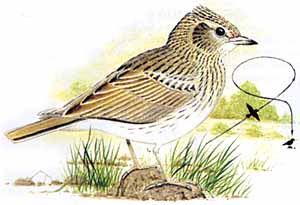
Common Skylark, Alauda arvensis (1)
(First Posted: 2004 02 22; Last Revised: 2016 09 17) ; Text appeared in the newsletter of the Eastern Sierra Audubon Society, The WAVE, May/June 2004 (Vol. 22, No. 5).
Birds have often been a source of thematic material for composers of classical music. I was recently inspired to explore this matter, deciding to limit the study to instrumental music. I came up with a list (3) of about 30 composers, from the Englishman Giles Farnaby (ca. 1563-1640), who wrote a piece for the harpsichord based on the call of the "Woody-Cock", to the Finnish musician, Harri Viitanen (born 1954), who composed a work he called "The Blackbird for Solo Oboe" over the period 1999-2001. Although some of
 Common Skylark, Alauda arvensis (1) |
My favorite bird of all time is the Common Skylark. When I, my wife, and our 2 daughters lived in Edinburgh for a few months in 1975, we often walked over to Blackford Hill, where Skylarks were to be found, and sat on the grassy slopes, letting ourselves be charmed by their song and aerobatics. One of the most frequently played pieces of bird-inspired classical music is Ralph Vaughn Williams' "The Lark Ascending", in which the Skylark is portrayed delightfully by a violin.
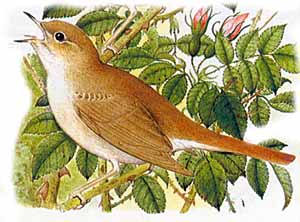 Common Nightingale, Luscinia megarhynchos (1) |
The Common Nightingale (a European Thrush) and the Common Cuckoo of Europe (a bit larger than our Yellow-billed Cuckoo), appear, together or separately, in many works. I have crossed paths with neither bird species, so I don't have the experience to understand what all the fuss is about there. Of course I've heard cuckoo clocks, and can stretch my imagination! The famous 2 notes are heard repeatedly, and thrillingly, in the first movement of Gustav Mahler's marvelous First Symphony.
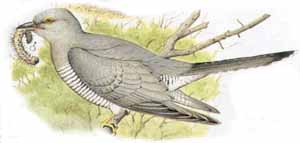 Common Cuckoo, Cuculus canorus(1) |
Ottorino Respighi (1879-1936) composed a familiar piece, more or less in a Romantic vein, simply entitled "The Birds", with sections devoted to the dove, the hen, the nightingale, and the cuckoo, all depicted by instruments. But, in a first, he used an actual bird
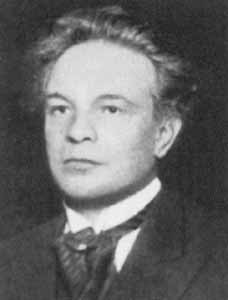 Ottorino Respighi Photo: H. Manuel; Source: Liner notes, "Dorati Conducts Respighi", Mercury Living Presence CD 432 007-2. |
Then there's the second movement of Beethoven's Sixth Symphony, "The Pastorale". You're on a walk through the woods, and come to a brook. At first all you hear is the rush of the waters, the birds having been silenced by your approach. But, after a while, the birds begin to sing, tentatively at first, then ever bolder. Both Cuckoos and Nightingales (and even Quail) eventually become raucous in song, as portrayed, that is, by instruments of the orchestra. Beethoven loved his walks in the woods, and wrote, "How glad I am to be able to roam in wood and thicket, among the trees and flowers and rocks. No one can love the country as I do ... my bad hearing does not trouble me here. In the country, every tree seems to speak to me, saying 'Holy! Holy!'. In the woods, there is enchantment which expresses all things."
The American composer John Luther Adams (born 1953), composes in a one room log cabin in Alaska. (He is not to be confused with a more famous contemporary John Adams.) In the 1970s he wrote a series of short pieces for piccolos and percussion, which he called "songbirdsongs". Environmentalist guru Edward Abbey, in a letter to Adams in 1978, wrote, "Your musical evocation of the hermit thrush . . . moved me to tears." When an artistic spirit captures well one of our favorite objects of nature, be it on canvas, music, or other medium, it can evoke deep emotion.
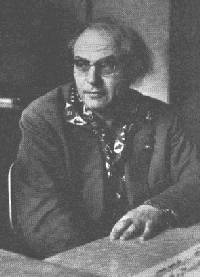 Olivier Messiaen Source: perso.wanadoo.fr/p.dubois/oiseaux/ |
Olivier Messiaen (Frenchman, 1908-1992) visited bird habitats all over the world, and recorded their songs in musical notation in the field; his wife, who accompanied him, captured the songs on tape as well. He wrote a large number of solo piano pieces, each based on the song or call of a specific bird; he also wrote chamber and orchestral works based on birdsong themes. He was called "An Audubon in Sound" in a great article about him, and birdsong as music, in the March, 1997, issue of "The Atlantic Monthly" (it's online). Highly creative souls, such as Messiaen, often hear things differently from us mortals, so it should be no surprise that many of his musical portrayals might be a bit difficult for even the expert birder to ID. Harri Viitanen took things further technologically, using a computer to process bird songs he had recorded himself, later incorporating the results into his music.
Of course, the ultimate involvement of bird song in classical music would be the use of live birds themselves. One might fancifully imagine a row of gilded cages suspended from similarly gilded stands, arranged to the conductor's left, in front of the violins; each bird, alertly watching the maestro, would belt forth whenever the conductor pointed the baton its way. Well, no one has quite done that yet, as far as I am aware, but it was interesting to learn, if true, that Mozart trained a pet Starling to whistle, in its entirety, all of one movement of his G major piano concerto, though the bird consistently sang two notes a bit flat.
The piece that inspired this little study is "Cantus Arcticus, Concerto for Birds and Orchestra", by Finnish composer Einojuhani Rautavaara. I first heard it
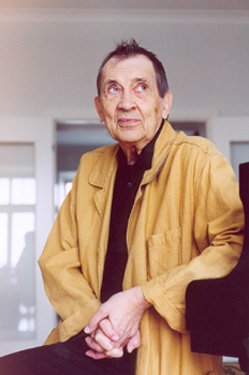 Einojuhani Rautavaara 2003 photo by Maarit Kytöharju (2) |
Other animals, of course, have influenced classical composers. Rimsky-Korsakov's "Flight of the Bumblebee" immediately jumps to mind. Similar in vein to Rautaavara's work is the 1970 piece by American composer Alan Hovhaness (1911-2000), "And God Created Great Whales", which incorporates recorded Humpback Whale sounds. No sounds are to be expected from the vegetable world, but nevertheless it also is represented in classical music, for instance a charming 1959 composition inspired by Linnaeus, "The Flower Clock", by Jean Francaix (1919-1997).
Should birders like to expand their birding horizons in this direction, the works mentioned are readily available on CDs and streaming on the internet (e.g., YouTube). A nice challenge might be to try to identify those arctic birds recorded by Rautavaara!
1. Bird illustrations are from a 1991 Russian language bird guide to the Balkans.
2. Courtesy Aarne Toivonen, Coordinator Contemporary Music [2004], Finnish Music Information Centre.
3.
Birds in Classical Instrumental Music: Composers and their works
Most of the information given here was gleaned from internet searches. Thanks to Ruth Blakely, and also Gary and Donna Lake, who helped recall some of the pieces, and to Aarne Toivonen (2), who alerted me to the 1999/2001 piece of Viitanen. Serendipitous listening to streaming audio from classical radio stations, especially the Australian Broadcasting Corporation's "All Night Classics" program, led to others.
Farnaby, Giles (c1563-1640), English; WOODY-COCK, keyboard
Walther, Johann Jakob (1650-1717), German; SONATA NO 10 IN G (Imitation of the Cuckoo), for violin, cello, and organ. The cuckoo and nightingale feature in other of his works.
Kerll, Johann Caspar (1627-1693), German; a CUCKOO CAPRICCIO for keyboard, 1686
Pasquini, Bernardo (1673-1710), Italian; CUCKOO TOCCATA, keyboard
Vivaldi, Antonio (1678-1741); THE FOUR SEASONS, for string ensemble; bird songs, 1725; THE GOLDFINCH, flute concerto
Rameau, Jean-Philippe (1683-1764), French; LE RAPPEL DES OISEAUX (the call of the birds); LA POULE (hen), keyboard
Handel, George Frideric (1685-1759) German/English; THE CUCKOO AND THE NIGHTINGALE, organ concerto, 1739
Couperin, Francois (1688-1733), French; LES FAUVETES (warblers) PLAINTIVES, LE ROSSIGNOL EN AMOUR (the nightingale in love), LE ROSSIGNOL VAINQUEUR (the victorious nightingale), keyboard
Daquin, Louis-Claude (1694-1772), French; LE COUCOU, keyboard
Mozart, Leopold (1719-1787), German; SLEIGHRIDE, bird calls, 1756; TOY SYMPHONY, toy cuckoo whistle (also ascribed to Josef Haydn, but neither piece may have been a work of these composers)
Haydn, Franz Josef (1732-1809); THE CREATION, bird sounds, 1798; THE LARK, string quartet No. 53 in D Major Op. 64, No. 5
Boccherini, Luigi (1743-1805); L'UCCELLERIA (The Aviary); String Quintet, op. 11, No. 6, in D Major (G276); 1771
Beethoven, Ludwig (1770-1827), German; SYMPHONY NO. 6, 2nd movement; cuckoos, nightingales, and quail, by a brook, 1808
Liszt, Franz (1811-1886), Hungarian; LE ROSSIGNOL, piano, 1842; SAINT FRANCIS OF ASSISI PREACHING TO THE BIRDS, organ/piano, 1863
Ellard, Frederick (1824-1874), Australian; AUSTRALIAN BIRD WALTZ, 1853
Saint-Saëns, Camille (1835-1921), French; CARNIVAL OF THE ANIMALS, 1886, Cuckoo, Swan and others
Dvorák, Antonin (1841-1904), Czech; AMERICAN QUARTET, third movement inspired by the song of the Scarlet Tanager (composed while Dvorák was visiting the Czech community of Spillville, Iowa, in 1893); THE WILD DOVE, symphonic poem
Grieg, Edvard (1843-1907), Norwegian; LITTLE BIRD from Lyric Pieces Op. 43 #4; MORGENSTIMMUNG, Peer Gynt Suite no. 1, bird call in fourth bar, 1875
Mahler, Gustav (1860-1911) Austrian; SYMPHONY NO 1, 1888, and others; cuckoos and nightingales
Delius, Frederick (1862-1934), English; ON HEARING THE FIRST CUCKOO IN SPRING, for small orchestra, 1912
Sibelius, Jean (1865-1957), Finnish; THE SWAN OF TUONELA, 1893
Ravel, Maurice (1875-1937), French; OISEAUX TRISTES, one of five pieces in the cycle "Miroirs", 1905, for piano
Respighi, Ottorino (1879-1936), Italian; THE BIRDS, 1927, orchestral; THE PINES OF ROME, 1924, first use of an actual bird recording
Prokofiev, Sergei (1881-1953), Russian; PETER AND THE WOLF, 1936
Villa-Lôbos, Heitor (1887-1959), Brazilian; BACHIANAS BRASILEIRAS NO. 4, with the call of the Araponga, or, the Bearded Bellbird, 1930
Vaughan Williams, Ralph (1872-1958), English; THE LARK ASCENDING, orchestral, 1921
Bartók, Béla (1881-1945), Hungarian; PIANO CONCERTO NO. 3, includes bird calls and said to be inspired by birds while living in North Carolina, 1945
Martinu, Bohuslav (1890-1959), Czech, SONATA FOR FLUTE AND PIANO, H. 306, third movement theme based on songs of an injured bird he nursed back to health in Cape Cod, flute and piano
Messiaen, Olivier (1908-1992), French; CATALOGUE D'OISSEAUX (1956-8), piano, lengthy work using bird song themes; also chamber and orchestral works (1940s-1980s)
Daetwyler, Jean (1907-1994), Swiss; DIALOGUE AVEC LA NATURE, alphorn concerto, bird portrayed by piccolo
Blank, Allan (born 1925), American; THIRTEEN WAYS OF LOOKING AT A BLACKBIRD, chamber piece (based on the poem by Wallace Stevens), 1965 (Other composers have also been inspired to write music based on this poem.)
Bernstein, Seymour (born 1927), American; BIRDS, suite of impressionistic studies, piano
Rautavaara, Einojuhani (1928-2016), Finnish; CANTUS ARCTICUS, Concerto for Birds and
Orchestra, 1972, taped arctic birdsSculthorpe, Peter (1929-2014), Australian; SONATA FOR STRINGS NO 3, sounds inspired by Australian birds, for chamber orchestra
Vasks, Peteris (born 1946), Latvian; LANDSCAPE WITH BIRDS, Flute solo, 1980; STRING QUARTET NO. 2, 2nd mvt "Birds", 1984
Viitanen, Harri (born 1954), Finnish; IMAGES D'OISEAU POUR ORGUE, organ, 1992; THE BLACKBIRD FOR SOLO OBOE, 1999/2001
John Luther Adams (born 1954), American (Alaska); SONGBIRDSONGS, piccolos and percussion, 1974-80; and 2 others
Sorensen, Bent (born 1958), Danish ; BIRDS AND BELLS, Trombone Concerto,